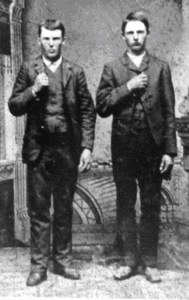In his new book Red Dead’s History, Tore Olsson reveals the gritty and brutal world that inspired the sensational video games Red Dead Redemption and Red Dead Redemption II, shedding light on dark corners of the American past for gamers and history buffs alike. Get a sneak peek of the book below!
Let’s start with a trivia question. From which of the Red Dead Redemption games is the following scene plucked?
It is the dead of night. In the borderlands between the American South and West, an outlaw gang has made camp in a farmhouse, laying low after a string of audacious train robberies. Yet their hideout is not as secret as they imagine. Encircling their camp that night are heavily armed agents of the Pinkerton National Detective Agency, a private police force tasked with arresting or killing the bandits. These gunmen know this is a particularly important mission, as they were given their assignment by the founder of the agency himself, who nurses a particular grudge against these outlaws because they had previously murdered two of his men. “They must pay,” the agency’s chief fumes. “There is no use talking—they must die.”
The Pinkertons’ plan to overtake the gang is elaborate. With the outlaws fast asleep, the agents lob a specially-built incendiary device through a window, giving them both light and the element of surprise. The plan is then to enter stealthily and shoot or arrest the bandits. But things soon go awry. First, it turns out that the gang’s leaders are absent from the farmhouse. Second, at least one outlaw isn’t sleeping when the flare drops through the window—and he leaps up and tosses the strange device into the fireplace. There it explodes in a terrific fireball, ejecting shrapnel that kills the eleven-year-old son of one gangmate and tears an arm off the gang leader’s elderly mother. These were not the intended targets, and now the Pinkertons’ advantage of stealth is lost. Frustrated, embarrassed, and fearing a bloodbath, the agents retreat into the night. The outlaws gloat at besting their adversary. “Pinkerton and his detectives can look for us in hell,” crows the gang’s leader with pride.
If you’re scratching your head to place this particular showdown within the video games, don’t blame your memory—it was a trick question. The scene and its colorful quotes are pulled not from the digital fiction of the Red Dead Redemption series, but from the pages of American history. The outlaws defying capture are the James-Younger gang, led by Jesse and Frank James. Their farmhouse hideout lay in Missouri, their home state. Bloodthirstily hounding the gang was Allan Pinkerton, founder of the private detective bureau bearing his name. And the outlaws’ outwitting of the Pinkertons was one of the great underdog upsets in the history of American crime and punishment.

Isn’t it startling, though, how this flesh-and-blood encounter sounds as if it was lifted from the narrative of the Red Dead Redemption games? This suggests the pains that Rockstar Games, the developer of the series, took to capture the world of the late 1800s. And indeed, as this book will reveal again and again, the video games frequently excel in showcasing the contours not only of outlaw life but also of American life, across a wide swath of the continent.
But before we neatly equate the James-Younger gang with the van der Linde crew of the video games, let’s consider the inconsistencies and flaws in such a comparison. The Pinkerton raid in Missouri took place during a decade when that agency was known for chasing western outlaws. Yet that decade was not the 1890s but the 1870s; the assault on the James-Youngers came in January 1875. By 1899 or 1911, the chronological settings of the games, the Pinkertons were frying bigger fish. They were breaking strikes at factories and infiltrating labor unions, not hunting bandit gangs. The quarter-century that separates the two makes a big difference. Likewise, we shouldn’t imagine the James-Younger outlaws as the mirror images of the crooked, violent, but ultimately sympathetic van der Linde gang. Jesse James and his brood were bad men in every sense of the word. Not only were they remorseless killers, but they also held toxic ideologies. The gang were former pro-slavery guerrillas who had fought for the Confederacy. They were unreconstructed white supremacists, who sometimes donned the uniforms of the Ku Klux Klan during their robberies. They were such obvious villains that they almost make the Pinkertons look like the good guys—and that is no easy task.
I kick us off with the 1875 Pinkerton raid in Missouri because it gives a representative taste of this book. In the chapters ahead, we will use the fictional characters and plotline of the Red Dead Redemption games to explore some of the thorniest dilemmas of American history between roughly 1865 and 1920. This is the half-century following the end of the Civil War, an era that Mark Twain famously called the “Gilded Age.” It appeared, at first glance, to be made of gold, but that glitter was just a thin veneer, and laying below was a rotten core of corruption, inequality, and violence. Whether you’ve sunk months into the games, watched them over someone’s shoulder, or never picked up a controller at all, I hope that the pages ahead reveal the powerful ways that digital games can shed new light on the triumphs and tragedies of the American past.
Copyright © 2024 by Tore C. Olsson

